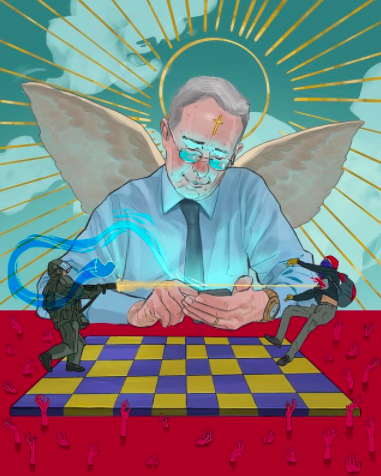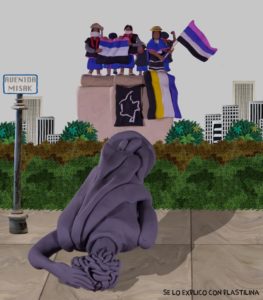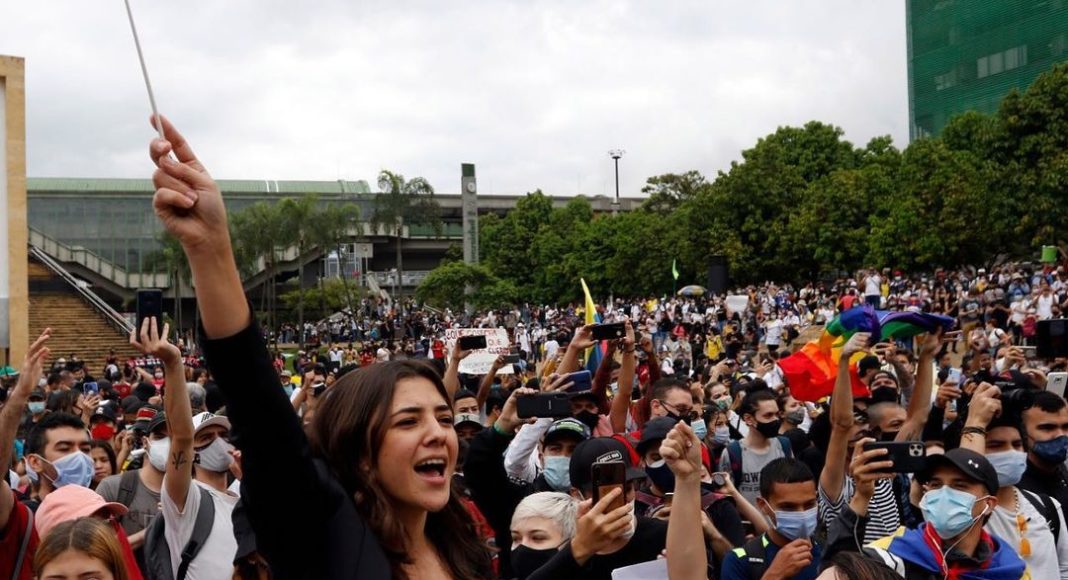In response to and support of nationwide protests across Colombia, artists of all trades have joined in protest through creative expression. Adapted from an article for LAB’s partner, Sounds and Colours, here are some of the ways in which art is enriching the protests, contextualising protesters’ demands and unifying Colombians.
Protests broke out across Colombia at the end of last month, when a national strike was proposed in direct response to a new Tax Reform bill that would further impoverish Colombia’s lower classes, who have disproportionately been hit by the COVID-19 pandemic.
Although protests were met with brutal violence from the state, this only seemed to galvanise citizens to join the strike. Students have taken to the streets, truck and taxi drivers are blocking key routes into cities and indigenous groups have arrived from rural areas to support those in Cali and Bogotá and make demands.
Despite the withdrawal of the tax bill and the resignation of finance minister, Alberto Carrasquilla, strikers have continued to demonstrate, broadening their demands since last year’s protests in November to encompass poverty, police brutality, corruption and inequalities in health and education, as well as massacres in Cali and the Pacific Coast, failure to rebuild Providencia after the hurricane, violence in Buenaventura, and the murders of dozens of social leaders and ex-FARC members since the peace agreement was signed.
Giving sound and colour to the protests, artists have expressed solidarity with Colombians online, in the streets, from home and from abroad. Here are some of the ways art is diversifying the protests, clarifying the message and unifying Colombians.
La #Marchanimada
In the ‘Marcha animada’ (animated march), Colombians who couldn’t leave their homes but wanted to show support for the national strike, joined an initiative proposed by illustrator and animation director, Daniel Cuervo, producer Juliana Rueda and 2D animator William Cifuentes – to produce short animations or graphics digitally representing themselves marching. The entries were then compiled using the hashtag #marchanimada.
Illustrating solidarity
Illustrators have shown both support for protestors and deep analysis of the situation in Colombia. Their work has been shared widely on Instagram and other social media sites.
Illustrator, designer and storyteller Yanneth Pineda from Itagüí (pen name: @yapicomics), created a series of satirical, affecting illustrations entitled ‘Esa no es la forma’ (This isn’t the way). In the image #sueña (dream), below, she contrasts the softness of sleep with the brutality of police killings.

#Sueña (Dream). Yapicomics
Artist Sergio Blandón Quintero created this striking image, which was widely shared on social media, depicting corrupt ex-president and alleged narcotrafficker, Alvarez Uribe, complete with angel wings and a crucifix, tweeting orders. His demands are played out by armed forces against civilians on the chess board beneath him, yet he appears blinded by the cold light of the phone screen. Beneath the chessboard, hands appear to claw for help from a sea of blood. The image was shared by thw widely followed news and media site, Primera Línea @primeralineacol.

Repurposing an illustration by the Cali-based Gráficas Molinari, journalist Andrea Yepes Cuartas wrote an accompanying text, detailing a young woman’s experiences of growing up and protesting in Colombia. The text accompanies a painting of a woman, chained and in flames. She writes:
“Growing up in this raging country under the burden of bloodshed, hunger and death, we’ve learned to dream of average things. We desire what should be guaranteed to us. […] here we simply wish to not be killed when we go out to protest, by a government committed to curtailing our rights and to imposing unequal reforms which ignore the everyday reality most of us live.
“We dream of women not being raped when they go out to exercise their freedom of expression, of not having to call a search party after each march because so many have disappeared. We use the expression ‘If only’ like this: ‘If only it weren’t images of the flames that got us out of bed each morning.”*
Explaining the situation with plasticine
Plasticine artist, Edgar Humberto Álvarez, uses his Facebook group ‘Se lo explicó con plastilina?’ to discuss issues in Colombia through short stop-motion ‘claymations’. His work covers disappearances, cacerolazos, the tax reform, motherhood, the Red Cross. In one piece, he portrays the moment in which Misak indigenous people pulled down the statue of Jiménez de Quesada in the centre of Bogotá this 7 May. Álvarez asks followers to think about what should be done with the statue and the empty space where it once stood.

¿Qué hacer con el monumento de Jiménez de Quesada? Se lo explico con plastilina?/Facebook.
Voguing in Plaza de Bolivar
Colombian artists Piisciiss, Neni Nova and Axid vogued in front of police and protestors to high-speed guaracha rhythms, demonstrating queer artistic resistance in this moment of extreme state repression.
“In moments like these when we are being censored, art must continue to be the path the towards light and visibility that we need,” Piisciis writes on Instagram, “When we raise our bodies and our voices, the world listens.”
Mass mobilisation
Embodying the unity they want to see, citizens on skateboards, bikes and rollerblades held onto each other and linked up with police motorbike, creating a striking people’s caravan on the streets of Medellín. This seemingly trivial act conveys an important message.
Anthems of the Strike
“Bella Ciao”, the ubiquitous 19th-century Italian folk song sung by the mondina workers in protest against harsh working conditions in the paddy fields of northern Italy, has once again been reimagined as a protest against Colombia’s president, Iván Duque. “Duque chao, Duque chao, ¡Duque chao chao chao!” has been sung and played across the country in recent days. There’s even a champeta version, a carranguera Andean revision and a symphony orchestra reimagining of the song.
In Medellín’s Parque de los Deseos, dozens of musicians took over the square to play as a unified orchestra, promoting unity and solidarity and expressing discontent with the government. Susana Boreal organised the initiative and continues to support other similar concerts in Colombia.
Paisa rappers Alcolirykoz joined caleño singer Junior Zamora on the track “La Caza de Nariño”, to talk about the complex and corrupt political situation. It’s a new song written in support for the marches taking place all over the country. The track criticises the ignorance of Colombia’s upper classes, calling out the failure of famous singers like Carlos Vives to speak up in the face of a national emergency, and the hypocrisy of Catholic education which teaches Colombians to oppose abortion yet devalue life.
22-year old Hendrix Hinestroza, from Cali, has been actively posting freestyles and gigs in support of the paro nacional. He started a TikTok challenge, asking followers to sing or rap over the track “¿Quién los mató?”, which was released last year, alongside fellow Afro-Colombian musicians Nidia Góngora, Alexis Play and Junior Jein, to speak out about the five Afro-Colombian children killed in Llano Verde in Cali last August. In the challenge, #quienlosmatoparonacional, he asks followers to reimagine the track in response to the current situation.
Colombian musicians in the UK, Desta French and Santiago Morales (from Bogotano beats collective Sello Indio), covered Violeta Parra’s “Una Carta” in solidarity with their brothers and sisters in Colombia. They say: “the lyrics resonated deeply with us, and what is happening in Colombia. Our hearts are in so much pain right now but the unity that the people of Colombia have shown is inspiring to say the least so it’s our duty to stay strong for the people still out in the streets, and show them love and support. All proceeds from this song will be donated to two trusted sources helping protesters who need it the most.”
Edson Velandia and Adriana Lizcano’s genius “Todo Regalao” was released just a day before the national strike began. The track and accompanying clownish video explain, through satire and acerbity, how many Colombains feel. “El salario del senao – lo pagamos nosotros / El senador relajao – lo pagamos nojostros … ¿Qué será que los ricos quieren todo regalao?”
They have also released the sharp-witted “El Infiltrao”, which discusses in clear, everyday language, how undercover police, military and paramilitaries have infiltrated protests dressed in plainclothes, in some instances framing protestors and in others, attacking protesters.
Some musicians, including Chocquibtown’s Goya, J Balvin, Shakira, Juanes and Maluma, supported protesters and lamented the violence in Colombia to varying degrees. A video from Shock compiled videos and comments of solidarity.
Our friends at Movimientos have put together a new crowdsourced playlist entitled ¡Resistencia Musical! The list includes a number of Colombian protest anthems, including the “Himno de la Guardia Indígena”. You can suggest more songs here.
This article was adapted from ‘ARTE PARA NO MORIR: ARTISTIC SOLIDARITY WITH COLOMBIA’, published by Sounds and Colours on 12 May, 2021. Translations are the author’s own.
Main image: Susana Boreal leads street orchestra in in Medellín’s Parque de los Deseos. Susana Boreal/Twitter

